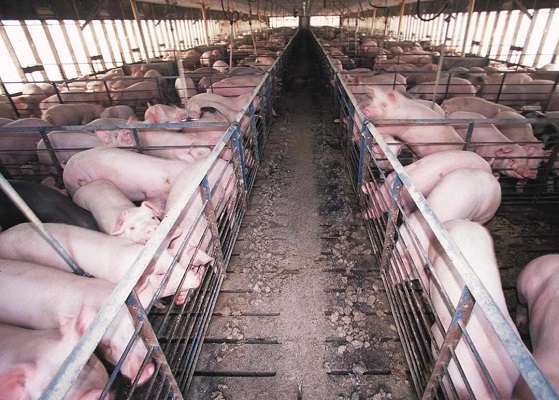

Normal behavior in pigs refers to behaviors that are observed in pigs under natural conditions. These behaviors promote biological functions in pigs, such as survival and reproduction. Since rearing environments for commercial production are different from natural conditions, indoor raised pigs do not display the entire repertoire of behaviors they perform under natural conditions. For example, free-ranged pigs spent 35-55% of their time foraging for food, while indoor housed pigs do not forage because food is readily available.
Farrowing and nursing behavior
On average, sows spend 2 to 4 hours giving birth to a litter, with an interval of 15 to 20 minutes between each piglet. However, there is large variation in farrowing duration (45 min to 12 hour) and inter-birth intervals (5 to 85 min) among individual sows. During farrowing, sows spend 85% of their time lying on their side.
At birth, piglets can present normally in either a ‘nose first’ or ‘hind legs first’ position. ‘Broadside on’ is considered a mal-presentation. Piglets can get on their feet within a few minutes and successfully suckle milk within 45 min after birth. Birth order may affect piglet survival and growth. Later-born piglets usually have less vigor, suckle later, obtain less colostrum, and have poor teat order compared to piglets born earlier. In addition, later-born piglets have a high risk of being stillborn or being born enveloped in afterbirth.
Nursing tends to be continuous at farrowing, and later becomes rhythmic. A sow nurses her piglets approximately once per hour. Nursing is usually synchronized among sows in the same room, meaning that sows within a room usually nurse at approximately the same time. Each nursing takes about 3 min, but the actual time of milk letdown only lasts 20 to 30 sec. On average, each piglet obtains about 0.7 oz (20 ml) of milk at each nursing.
Resting behavior
Pigs spend the majority of their time resting or lying. On average, grow-finish pigs spend 75 to 85% of their time lying, and 5 to10% eating, with the remainder of their time involving in other activities such as walking, sitting, rooting/nosing, and drinking. Within the thermal comfort zone (i.e. the temperature range when pigs spent the least energy to maintain their body temperatures), lying on their side (lateral lying) is the predominant posture, with about 40 to 50% of pigs touching each other. When temperatures are below the comfort zone, pigs adopt a sternal lying posture (on their chest and stomach)and huddle together to reduce the exposed skin surface area for heat loss. Under very cold conditions, pigs may lie on top of each other to keep warm. Above the upper limit of the thermal comfort zone, pigs change their lying position from sternal to lateral with legs stretching out and avoid contact with other pigs. Under extremely hot conditions, pigs increase their respiratory rate (panting) to dissipate heat through evaporation from the respiratory tract.
Eating and drinking behavior
On average, pigs eat 10 to 25 meals per day, with younger pigs having more meals than older pigs. Nursery pigs can eat 20 to 25 meals per day,while finisher pigs may eat only 10 to 15 meals per day. As pigs grow, they eat faster, so older pigs spend less time eating compared to younger pigs. Eating events peak in the morning and evening. Even though pigs will eat during the night, the number and duration of meals is less than during the day. When feeder space is limited, pigs will increase the amount of time spent eating during the night, which changes their diurnal (daily) pattern of eating behavior. For example, diurnal variation in eating behavior is reduced when there are 20 pigs per feeder space, and is completely diminished with 30 pigs per feeder space, compared to 10 pigs per feeder space. Increasing the length of the light period can also increase the number of meals and diminish the diurnal variation in eating behavior in pigs.
Eating behavior can be socially facilitated. When a hungry pig is eating adjacent to a satiated pig, the satiated pig typically starts eating. Furthermore, pigs in adjacent pens tend to eat at the same time. However, when feeders are close together without protective dividers, pigs will avoid eating together and are aggressive towards other pigs that are eating next to them. Pigs learn what to eat and where to eat from other pigs. Pigs that have observed other pigs eating a novel diet are more likely to eat the novel diet than pigs that have not. In addition, pigs that have observed other pigs eating from one of three feeder troughs will eat from the same feeder if given a choice.
Excretory behavior
Pigs like to excrete in cool and wet areas, and lie in warm and dry areas. Pigs often drink, urinate, and defecate in close proximity of each other [23]. Because pigs take an unstable stance when they are excreting, they tend to excrete in a place that is away from commotion, and most commonly in a corner or against a wall. In most pens, the majority of the commotion is near the feeding areas so pigs tend to excrete away from feeders. If water is spilled, the pigs lie away from that area and then use it as an excretory area. So, pigs usually create the dunging area near drinkers. Pigs also like to excrete along the opening partitions between pens due to either drafts or the natural marking behavior when they see other pigs in the next pen . Both higher room temperatures and a higher stocking density can cause pigs to foul the pen.
 Contact Jaguza Support
Contact Jaguza Support